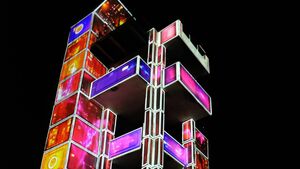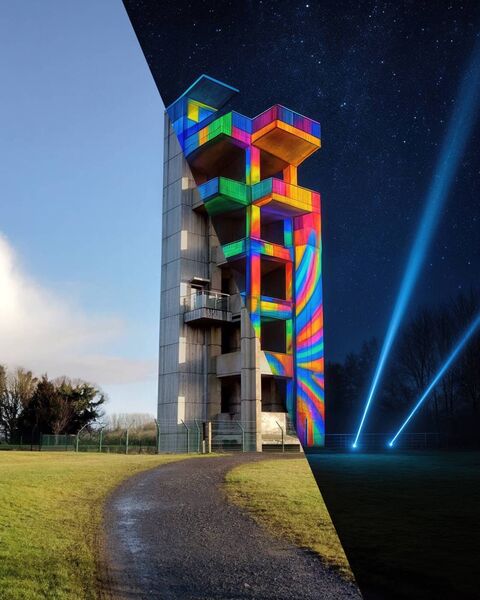From monstrosity to Tik Tok sensation: How Moylurg Tower refused to be forgotten

During the Night and Day music festival, Moylurg Tower was transformed into a dynamic, immersive art installation. Pic: David Knight
It feels like a delightful irony to write about why I love the Moylurg Tower, a brutalist concrete structure nestled in Lough Key Forest Park, County Roscommon. For many years, this building was reviled by locals and branded a “monstrosity” on Irish national television. Yet, to me, it is a treasure—a piece of personal and architectural history tied to my late father, the modernist architect James “Jim” Fehily.
My father, a pioneer of modernist architecture in Ireland, designed the tower in the late 1960s. Its story is one of contradictions, resilience, and, ultimately, redemption.
Born in 1930, my father along with my mother obtained their Bachelors of Architecture from University College Dublin in 1954. He studied under master architects in the United States and they both worked with the famous modernist landscape architect Dan Kiley in Vermont before returning to Ireland to champion modernist ideals.
Their practice, Fehily and Associates, designed the Moylurg Tower in 1971 as part of a commission by Bord Fáilte—The Irish Tourist Board—to transform the parklands around Lough Key into a forest park. Rising six stories and 150 feet high, the reinforced concrete structure replaced the charred remnants of Rockingham House, a grand Nash-designed mansion destroyed by fire in 1957. It was built during a time of architectural experimentation in Ireland, when brutalism was making its bold, controversial mark.
But not everyone shared my father’s vision. In its early years, the Moylurg Tower was despised by the local community. To many, it represented an unwelcome departure from the grandeur of Rockingham House, a symbol of heritage that had once dominated the landscape.

My father’s stark and unapologetic design was a futuristic statement and jarring contrast to the bucolic surroundings. One commentator famously called it an “architectural blemish,” while a 1995 segment on Ireland’s National Broadcaster, RTÉ’s Nationwide labelled it ‘Eyesore of the Week.’ Fergus Ahern, a local arts organiser, declared the tower had “no artistic value,” adding insult to injury by claiming my father hadn’t even signed his name to the project.
To me, these criticisms always stung. My father believed in the tower’s potential to create harmony between the manmade and the natural. The tower, 150 feet in height and six stories tall, was meant to offer panoramic views of the park, inviting visitors to marvel at the landscape. It was a modernist statement in a rural setting—an act of courage and imagination.
Growing up in a large Victorian house in Dublin with six siblings and an upstairs architectural practice run by my parents, I had always been surrounded by my parent’s visionary designs. The Moylurg Tower, in its raw and functional beauty, was a manifestation of his belief in modernism’s capacity to elevate human experience.
For years, the tower stood unloved, a relic of a bygone era and the proportions of the tower were compromised when the lift shaft was added for health and safety reasons in the mid-2000s, ruining its pure lines for aesthetes. Yet, over time, its fortunes began to change. In 2019, on the longest day of the year, the Moylurg Tower became the focal point of a participatory art performance called Before the Last Sun Sets. Commissioned by Roscommon Arts Centre, the event celebrated the layered histories of the tower and parklands through film, sound, costumes, and collective ritual. Participants brought the building to life, reclaiming it as a site of meaning and connection.
This artistic revival was further ‘cemented’ by Yvonne McGuinness’s documentary What’s Left Us Then, a poetic exploration of brutalism in rural Ireland. The film highlights the tension between the bucolic and the brutalist, portraying structures like the Moylurg Tower as both enduring and alien in their landscapes. McGuinness described the tower as an “absolute oddity” and reflected on its resonance with themes of unbelonging and home—concepts that spoke to me deeply. Watching the documentary, I felt a renewed pride in my father’s work. His once-dismissed design was now being recognized for its boldness and beauty.
The recent 'Night and Day Festival' in Roscommon featured the tower being lit up and used as a stage for musicians, it has yet again shifted shape in the public imagination. For me, the tower is more than an architectural statement; it’s a family heirloom. A line drawing of the Moylurg Tower by an Irish artist hangs prominently in my kitchen, a daily reminder of my father’s legacy. My children have always thought the tower looks like something from Star Wars, its angular silhouette evoking the futuristic imagination of their grandfather. Every time I visit the west of Ireland, I make a point of climbing the tower. From the top, the views stretch over 350 hectares of forest and parkland, offering a perspective that feels timeless and transcendent.
My father, who died in 2020, didn’t live to see the Moylurg Tower and Brutalism’s rehabilitation. But I like to think he would have been delighted by its newfound appreciation. This unyielding concrete structure, once deemed an eyesore, now stands as a testament to architectural vision and resilience. It is proof that beauty can take time to reveal itself, and that what may seem alien or strange can become beloved.
The story of the Moylurg Tower is one of transformation. It rose from the ashes of Rockingham House, endured decades of scorn, and emerged as a symbol of brutalism’s enduring appeal. It represents the courage of an architect who dared to challenge convention, and for me, it embodies a deeply personal connection to my father and his legacy. As I stand at its base or gaze out from its summit, I feel a profound sense of belonging—to my family, to the Irish landscape, and to the enduring power of architecture to inspire and provoke.






